The Chapel of the Holy Guardian Angels "Molenbosch Country Estate"
This is the continuation of the meeting with Coos van Wageningen during my walk through the Molenbosch. He tells me about the "Chapel of the Holy Guardian Angels", shows me the inside and I am allowed to take a photo report. Today my long and fervent wish to see the inside of the chapel comes true.
He is already waiting for me in front of the house and after a warm greeting with also his three dogs we walk to the chapel. In order to be able to take beautiful photos and to not let the paintings on the windows be disturbed by the view of the house and tree leaves, Coos stretches a white sheet on the outside in front of each window with the help of a ladder and glue clamps. He shines a studio light outside the chapel on the windows so that I can take beautiful pictures inside.
The founder of the chapel
But first something about "the founder of the chapel" J.F.A.A. (Joachim Ferdinand) de Beaufort (1927-2007). Great-grandson of A.J. de Beaufort and A.A. de Beaufort - Stoop, son of A.J. de Beaufort and A.L.C. de Beaufort - Stiepermann.
After studying Theology in Utrecht, Joachim Ferdinand moved to Gulpen. From there he served as assistant pastor in the Lutheran Church in Heerlen and in the Deutsch Evangelische Kirche in Aachen. He also taught church music at the Conservatory in Cologne. Later he joined the Old Catholic Church and then the Catholic Church. As a theologian, musicologist and as emeritus deacon (Greek: retired servant), Joachim Ferdinand held the Liturgy of the Hours daily in the last years of his life. Everyone was welcome at these services.
The Liturgy of the Hours “Liturgia Horarum” which literally means “Liturgy of the Hours” is the common prayer of the church and consists of 150 Psalms. Each mystery time (the Liturgical year/church year has six) has its own psalms that are always divided over the hours according to the order of the Book of Psalms. You can find these mysteries further on. By reading or singing different psalms daily, you will penetrate more and more into the divine prayer book.
Since the death of Joachim Ferdinand in 2007, the chapel has no longer been in use and is only accessible for viewings led by “Gilde Zeist”. This guild is actively committed to the Zeist community.
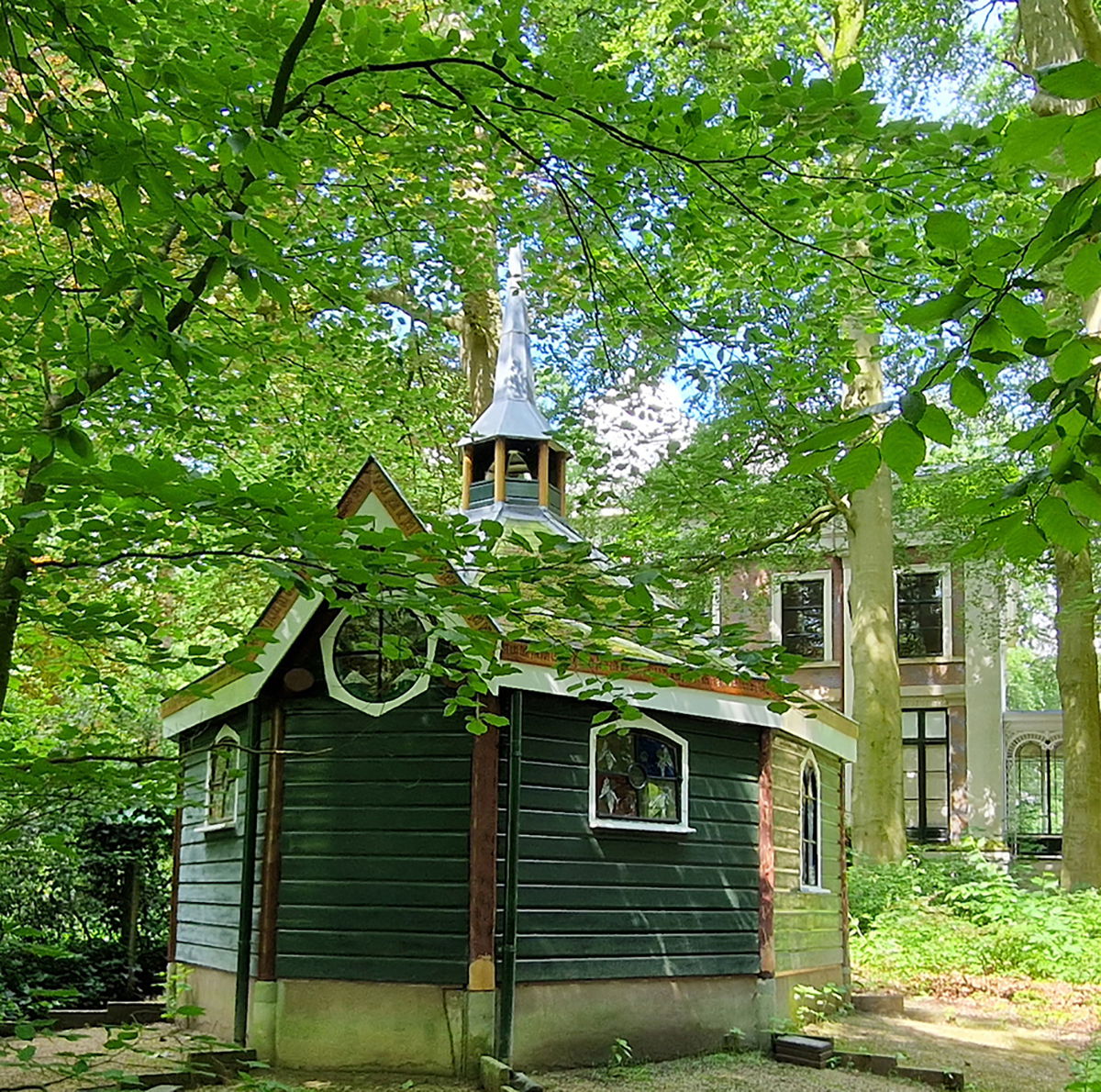
Hidden between old beech trees next to the house, it seems as if this chapel has been there for a century. The chapel is dedicated to the Holy Guardian Angels and was built in three years. On 2 October 1989 (the day of the feast of the Holy Guardian Angels), the chapel was consecrated by the archbishop of the Old Catholic Church, Mgr. Glazemaker.
It is actually a mini-church and perhaps the smallest in the whole of the Netherlands. Hers was a small barn chapel, which stood in the village of Zetten in the Betuwe.
Design and construction
Joachim Ferdinand was frugal with paper. He drew different variations of chapels on the back of old calendar sheets. He also made three-dimensional models to scale from old cardboard.
Ultimately, he opted for a seven-sided basic shape, in which the converging walls opposite the front facade are, as it were, folded out. This created an eighth wall that is parallel to the front facade. Above the roof towers a high spire with a “trumpeting angel” as a weather vane. This gleams in the sunlight and seems to call us.

Joachim Ferdinand designed the chapel down to the smallest detail and helped with its realization. Many others helped with the construction and furnishing of the chapel. Joachim Ferdinand's brother-in-law, Jacob Gerard van Wageningen (1922-2012), devised the roof construction as a civil engineer. Carpenter Herman Postma took on the practical implementation. Sister of Joachim Ferdinand, Digna Wilhelmine Ernestine de Beaufort - van Wageningen (1929-2008), painted the windows of the chapel together with artist Han van den Bosch.
Han van den Bosch (the maker of the bronze statue "Miss Annie De Beaufort, looking back at the House"), also made the "trumpeting angel" as a weather vane. The choir screen was welded by the metalworker of the Molenweg, Mr. De Vree, and nephews of Joachim Ferdinand made the lecterns and tables of the interior.
Credo in eaves
In the 10 eaves around the entire chapel, Joachim Ferdinand engraved the text of the Credo (the Confession of Faith) in Latin, with millimeter precision, using a milling machine. It is beautifully done and, to remain in terms of faith, it must have been a painstaking task. In the photo gallery you will find the entire creed in Latin and Dutch including the eaves.
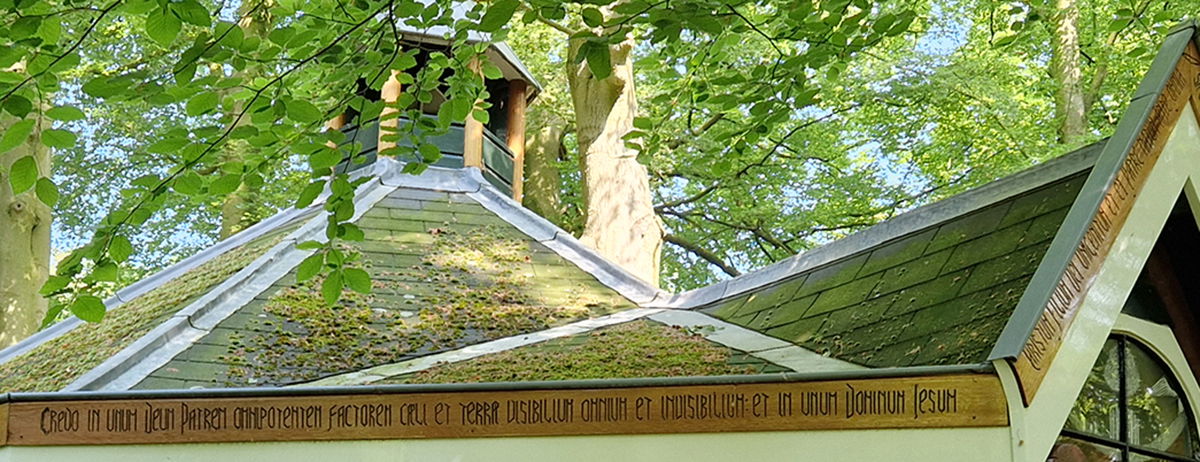
Then the moment arrives and I am allowed to see the chapel from the inside. It overwhelms me and it is much more beautiful inside than I had thought all those years.
Youth
My thoughts immediately go back to my youth. From the age of six to twelve I lived in Enschede at the Zuidkamp near Twente Air Base. There was a military chapel at the Zuidkamp where I was an altar boy on Sundays. But that chapel was nowhere near as beautiful as this one.
Every day I also walked along narrow paths through fields and meadows to the Roman Catholic boys' school in the village of Lonneker. At the time, this was an Asterix and Obelix village with unpaved roads and strict separation between Catholics, Protestants and non-believers. Before school started, I had to go to church and I was an altar boy there too. The best students in the class were allowed to serve the festive wedding services and high masses. For me, the services at 07:30 and funerals were reserved. Yes, those were times of power, order and discipline.
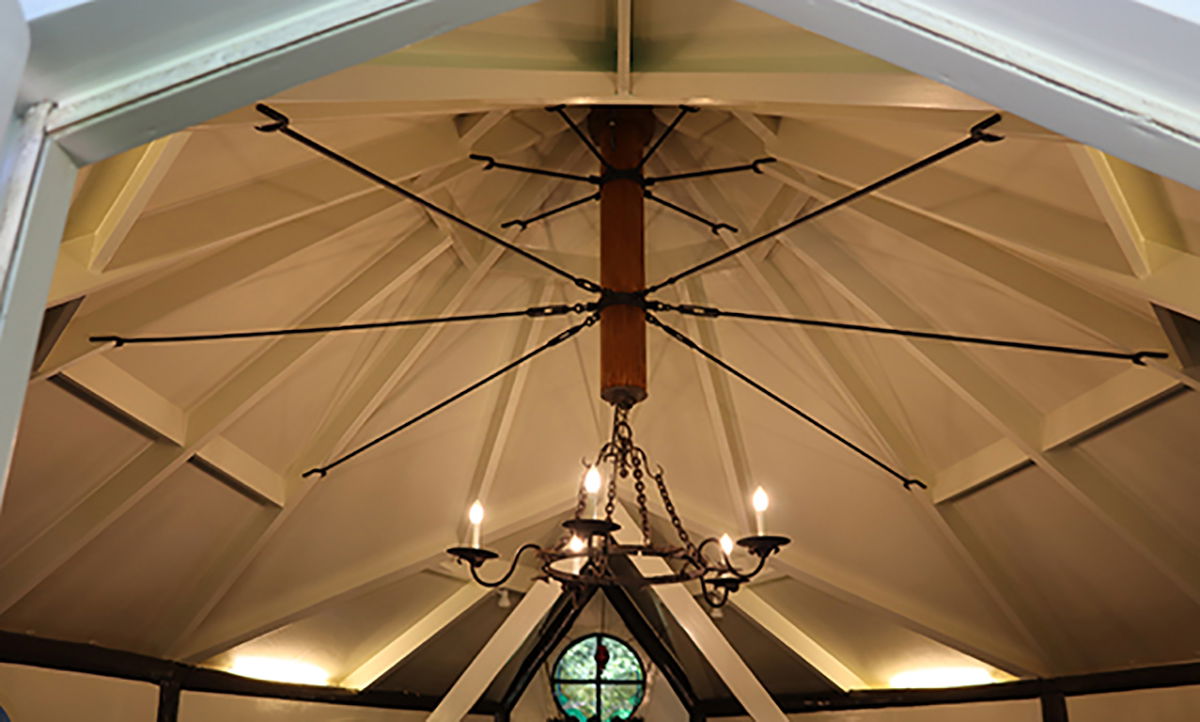
Seven
The first thing that strikes me is the roof construction. At the top, seven short and seven long tie rods connect the corner rafters with the central king post. They hold the roof surfaces together. An iron chandelier with five candles hangs below the post.
The chapel consists of the chancel and the nave. The choir screen separates the chancel where the priests sit from the nave where the visitors sit.
Within the chancel, the altar (offering table) is central. This altar is small and square, as in Eastern churches, and is placed against the wall. This is to banish thoughts of “human institution for spiritual cosiness”.
Within the chancel, the gospel “Good News” is sung and prayed during mass on the gospel side on the left, and the Epistles of the Apostles are read on the epistle side on the right.
The chancel faces east, because this is the direction where the sun rises and because Jesus is seen as the 'Light of the World'. According to the Bible, Jesus will return to the east to judge the living and the dead.
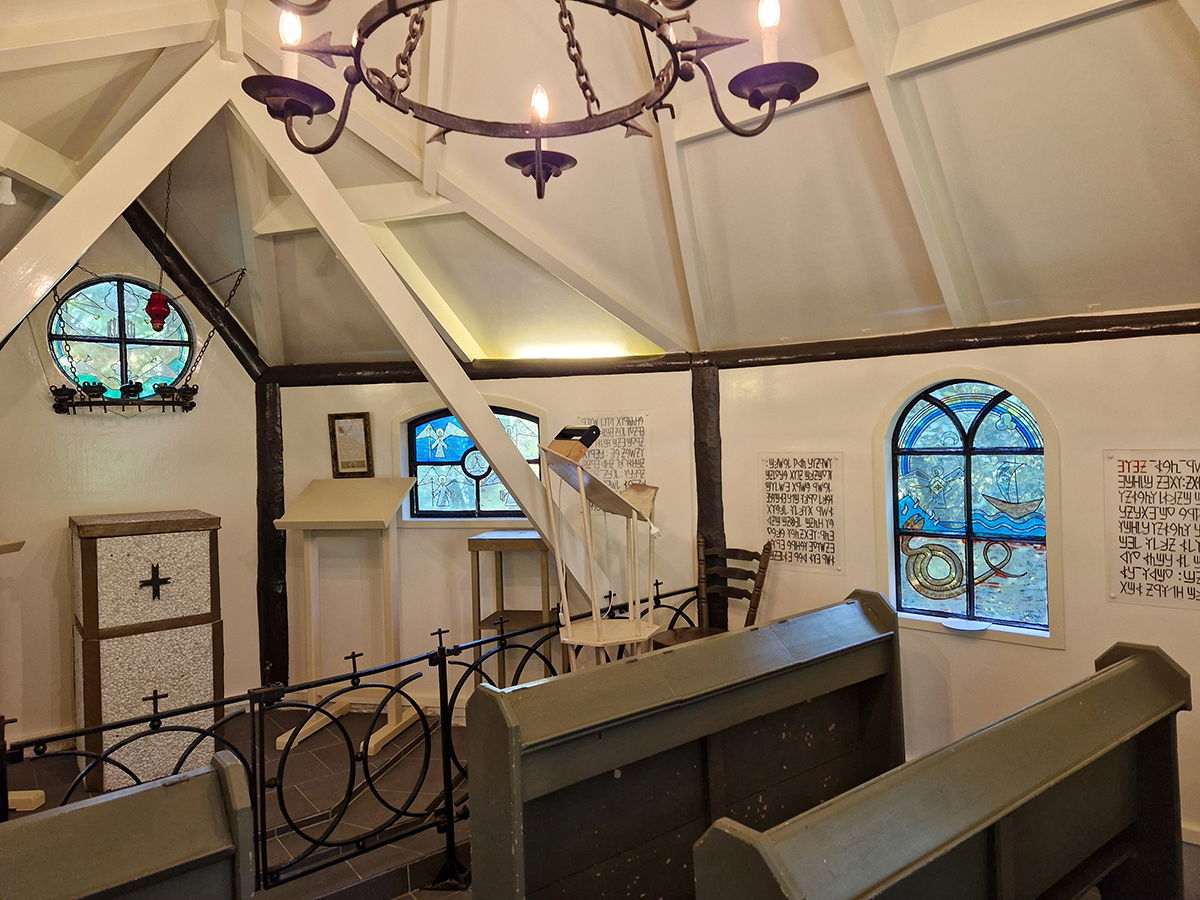
Above the altar hang the five Lights with the red Divine Lamp above them. These are lit when the Holy of Holies is present in the Tabernacle. The Tabernacle is a transportable sanctuary, with a cube-shaped space in it which is the Holy of Holies. In it are the chalices for water and wine and a bowl with the bread. Both symbolizing “The blood and body of Christ”.
The five lights symbolize the sustained prayer (praying until the prayer is answered).
Pews
The six old pews come from the Old Catholic St. Jacobus Church (1870-1989). This was located on the Bemuurde Weerd in Utrecht. In the backrests for the kneeling pews are slanted cupboards in which missals and bibles were kept.
I still remember that in my youth I had to kneel on these kinds of wooden benches with bare knees. They were hard and the sand on them scraped my knees. Cushions were only intended for adults at that time.
Painted windows
And then those ten beautiful windows painted in many colours on plexiglass. They come into their own in the sunlight. The colours are fading due to the (sun)light and will unfortunately disappear completely in the long run.
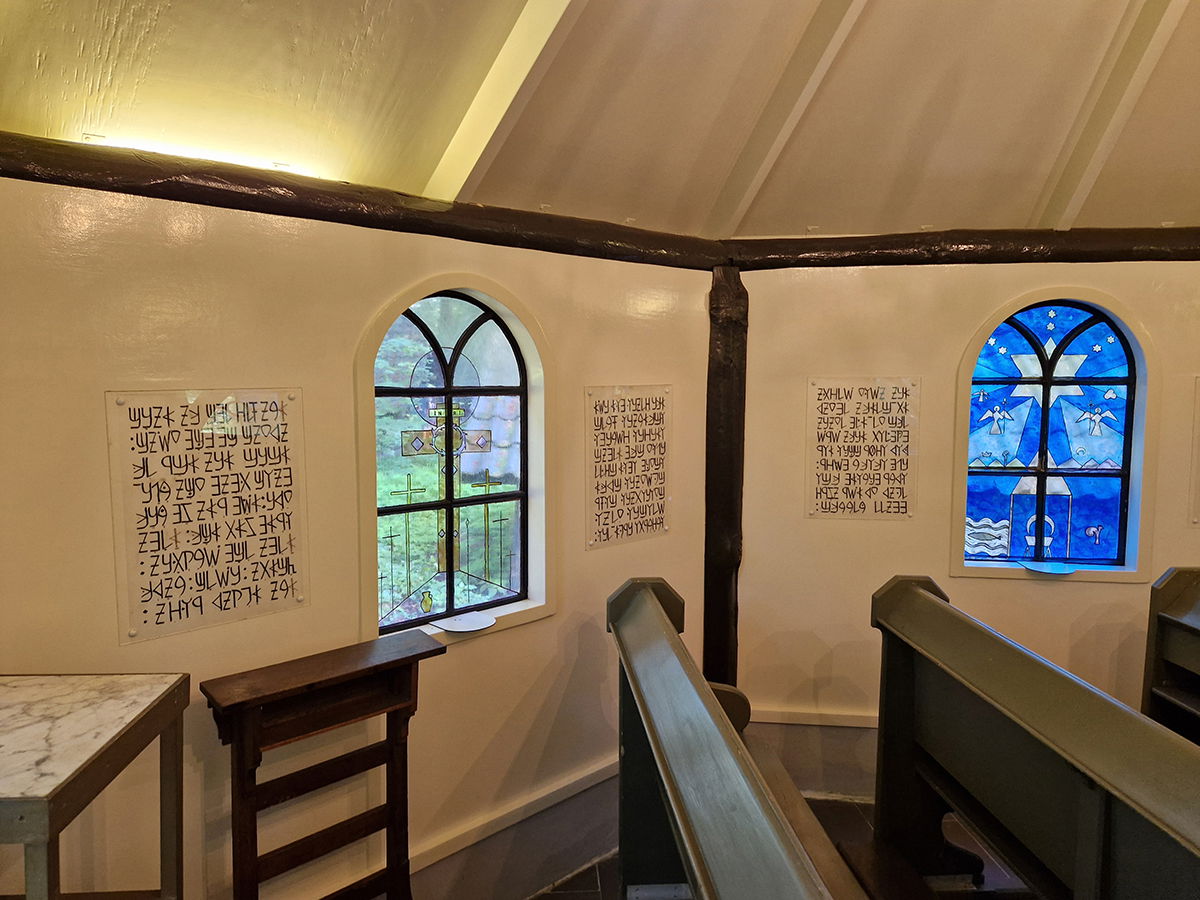
The church year (Liturgical year) is divided into six parts (mysteries), in the order below and does not run parallel to our calendar year. Each mystery has its own symbol and dominant colour that you can find in the windows.
The windows, together with the Hebrew Bible texts written by Joachim Ferdinand himself, follow the thoughts of the church year and run parallel to the Credo in the eaves on the outside of the chapel. There is a plateau under each window on which a candle burns when this particular mystery is discussed.
1. The Christmas mystery “Star of Bethlehem” with Isa. 45:8, Luke 2:14 Rev. 22:16 and 2 Pet. 1:19
The color of the mystery is blue.
The central symbol is the white six-pointed King David's Star. With the six small stars above it, it forms the seven stars spoken of in the Apocalypse (end of the world). From it, lighter blue, broadening rays emanate.
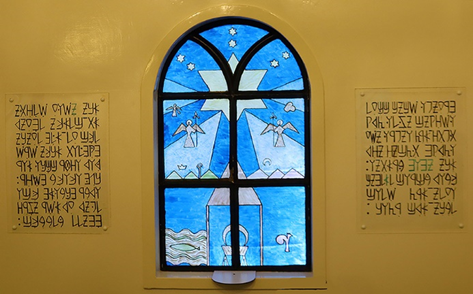 At the bottom, you can see the stable with the manger in it. The downward-facing crescent moon always symbolizes Mary. Next to the stable is a rooster (vigilance) as a sign of Advent. On the left, between the wavy lines, a fish as a sign of the gospel stories. In the middle right, the crescent moon Mary with the mountains of Ephraim below her, over which she traveled to Elisabeth. Above that, the Angel Gabriel with a halo and lily staff, representing the Annunciation of the Lord. Diagonally above Gabriel is the mystery of God depicted as a white cloud with three intersecting circles (Trinity: the Father, the Son and the Holy Spirit). In the middle left are the mountains of Ephrata with above them the announcement by Gabriel of the Christmas message. Above them a small angel with a trumpet as a sign of the angelic song. Below Gabriel the symbols of the crosier and crown of the ecclesiastical and worldly authority of shepherds and kings.
At the bottom, you can see the stable with the manger in it. The downward-facing crescent moon always symbolizes Mary. Next to the stable is a rooster (vigilance) as a sign of Advent. On the left, between the wavy lines, a fish as a sign of the gospel stories. In the middle right, the crescent moon Mary with the mountains of Ephraim below her, over which she traveled to Elisabeth. Above that, the Angel Gabriel with a halo and lily staff, representing the Annunciation of the Lord. Diagonally above Gabriel is the mystery of God depicted as a white cloud with three intersecting circles (Trinity: the Father, the Son and the Holy Spirit). In the middle left are the mountains of Ephrata with above them the announcement by Gabriel of the Christmas message. Above them a small angel with a trumpet as a sign of the angelic song. Below Gabriel the symbols of the crosier and crown of the ecclesiastical and worldly authority of shepherds and kings.
2. The Cross mystery with Isaiah 53:4,6 and the seven words of the cross.
The colour of the mystery is black, but here different because of transparency.
The central symbol is the Latin Cross on which the Lord Jesus was crucified and which stood outside the old walls of Jerusalem in the middle of the hill Golgotha.
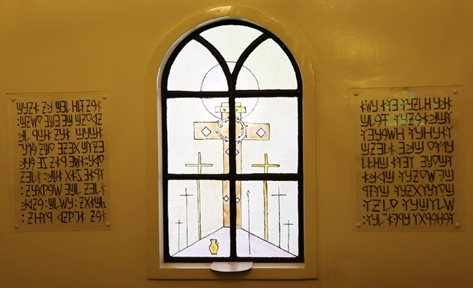
The wounds of the crucifixion of Jesus are indicated by squares at their point. Two pierced hands on the horizontal main beam and two pierced feet on three quarters of the vertical main beam. The side wound (the “Sacred Heart”) is located in two halves in the middle of the vertical main beam because of the symmetry. The crown of thorns in the middle indicates the celebration with a sign above it with the letters INRI. Behind the cross a ring as an eclipsing sun. On either side of the cross are the two crosses of the murderers that are symbolic for humanity. These have four smaller crosses next to them and together with the other three crosses symbolize the seven words of the cross. On the right in front of the cross the lance with which Jesus was pierced and on the left the jug from which Jesus was offered something to drink just before he died. The soldiers offered him a sponge soaked in sour wine. Both symbols of man’s failure and of the fulfillment of the prophecy of salvation (Prediction).
3. The Easter mystery “Rising sun, white cloud, Dove” with Mt.28:2,3, Psalm 47:6, 7, Joel2:28 (or 3:1)
The color of the mystery is gold.
The central symbol is the rose window above the door and indicates the Ascension. The white cloud of the Divine Hiddenness is above against the golden yellow background and from there rays emanate. On the Mount of Olives below are two Angels who announce the Second Coming.
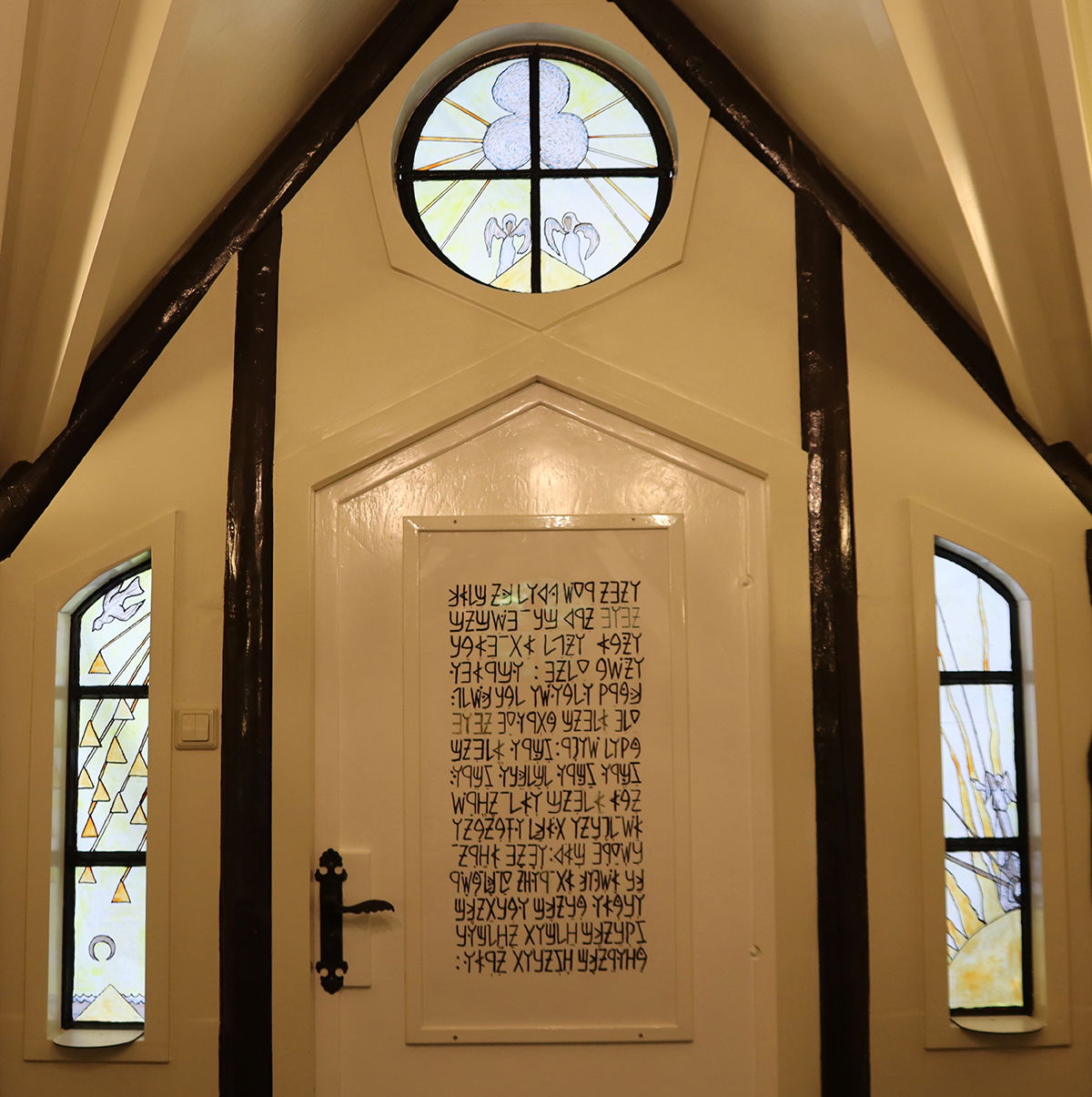
Easter with resurrection (symbol: rising sun) is celebrated on the first Sunday after the first full moon in spring, so after March 21. Forty days after Easter is Ascension Day (symbol: white cloud). This is the day on which the ascension of Jesus to God is commemorated. Ten days after Ascension Day, Pentecost (symbol: dove) is celebrated, the birth of the church.
The resurrection is symbolized in the narrow window on the right. At the bottom you see a partially visible rising sun disk with rays. At the bottom right window you see a gray symbolic grave rock with a white opening from which rays come. On the rock is the Angel who says "He is not here" and points diagonally upwards, but not yet to Heaven.
In the narrow window on the left at the top you can see the outpouring of the Holy Spirit (symbol: white dove). The flames of the Pentecost fire are twelve triangles hanging from rays. Below that is the crescent moon of Mary with a mountain and sea below it as the claiming of the entire world by the Holy Spirit.
4. The Mission Mystery “The Cross of Jerusalem with arrows to the ends of the earth” with Mt. 28:19, Psalm 97:1, and Isa. 2:3
The color of the mystery is red.
The central symbol is the Jerusalem cross from which the message goes out to the four ends of the earth. In the middle of the Jerusalem cross is the white dove of the Holy Spirit and around it four crosses.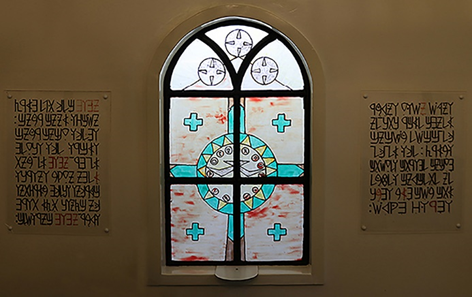
In the wreath on this Jerusalem cross are the twelve triangles for the apostles. In the inside of the circle are twelve symbols of these apostles with John as the only non-martyr in a white circle. These are Peter, John, Andrew, Judas, Simon, Thomas, Philip, Bartholomew, Matthew, James, Matthias and James, Clockwise from the middle left window.
In the curve of the window is the mountain Thabore with on the slopes three white circles (clouds) with four rays: symbol of the transfiguration of Jesus.
5. The Battle Mystery “The Ship of the Church on turbulent waters” with Joshua 5:14, Rev. 12:7,8 and Eph.6: 11-13
The color of the mystery is brown. The central symbol is the ship of the church in the storm of times under the rainbow of God's faithfulness.
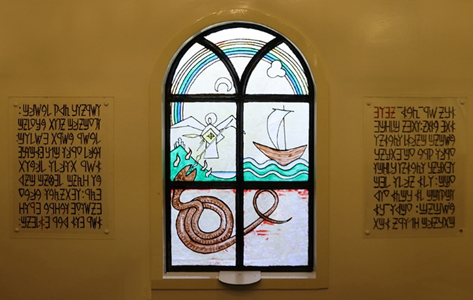
The sailed ship sails on the waves. The rainbow is a three-quarter visible circle from the right window curve to the left water surface. Above the ship is the Covenant cloud and to its left the crescent moon. In front of the ship flies the Angel Michael with shield, sword, lightning and golden spear. The sea is continued by a still surface (the “sea of glass” from the Apocalypse) and on the mountain on the left bank is a white city “the heavenly Jerusalem”. The bottom of the window is occupied by a winding dark snake. The head with open mouth with flames around it is struck by the spear of Michael.
6. The mystery of the Last Things “Lightning and trumpet of the Last Judgment” with at the side in the chancel the Psalm 98:7,8,9, Mt. 24:27,42 and Rev. 21: 4b,5
The color of the mystery is white consummation.
The central symbol in this rose window at the top of the chancel is the descending Jerusalem with the four trumpets.
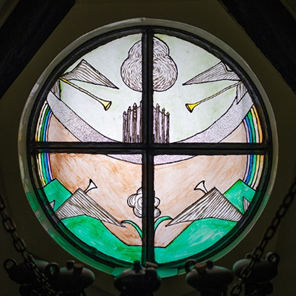
In the upper half are the white Trinity cloud with below it a city wall with towers and silver roofs with on either side a trumpet with angel wing of the blower. All this above a wide semi-circular band, symbolizing the supernatural light shine.
On the sides along the edges are pieces of rainbow in the same spirit. The bottom has two mountain tops against a light background. In front of them are again two angel wings and two trumpets visible. In the middle blooms a white rose (as which will bloom in the desert according to the prophet's word).
In addition to the windows of the mysteries, there are two more very beautiful windows on both sides of the altar representing the four apocalyptic Beings and the four Archangels.
The four apocalyptic Beings
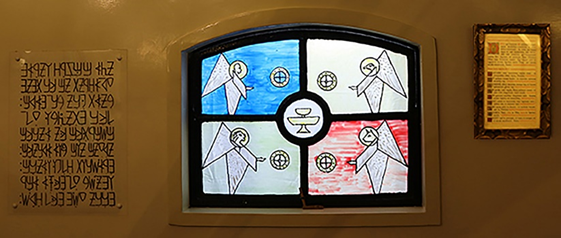
This window in the chancel on the gospel side is intended for the Eucharist. In the middle circle you see a golden chalice and bowl as a sign of the Eucharist. In the four window sections there is always one of the apocalyptic Beings in angel form with a halo. In front of them is always a wheel of four spokes and twelve precious stones on the golden rims. The background, eyes and gemstones are blue for humans, yellow-brown for the lion, silver-grey/white for the eagle and red for the bull. The collars that fall within the halo are in a lighter form of the same colours.
The four Archangels
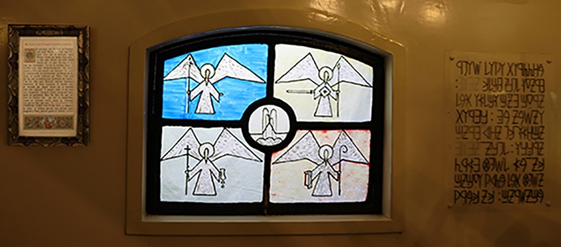
This is a window in the chancel on the epistle side and is intended for the sacraments (sacred words and actions). In the circle a fountain is indicated with water as a symbol for Baptism. At the top left is Gabriel with a golden lily staff and the other hand extended for the giving of Absolution (forgiveness of sins). At the top right is Michael with a golden spear and shield and in the other hand the sword extended for the knighthood of the Confirmation (confirmation). At the bottom left is Raphael with a golden pilgrim's staff or T-shaped Cross and in his hand a golden jar and two golden rings for the Marriage and the Last Anointing. At the bottom right Uriel stands against a background with a shepherd's (bishop's) staff and in his hand a stole (cloth) for the ordination.
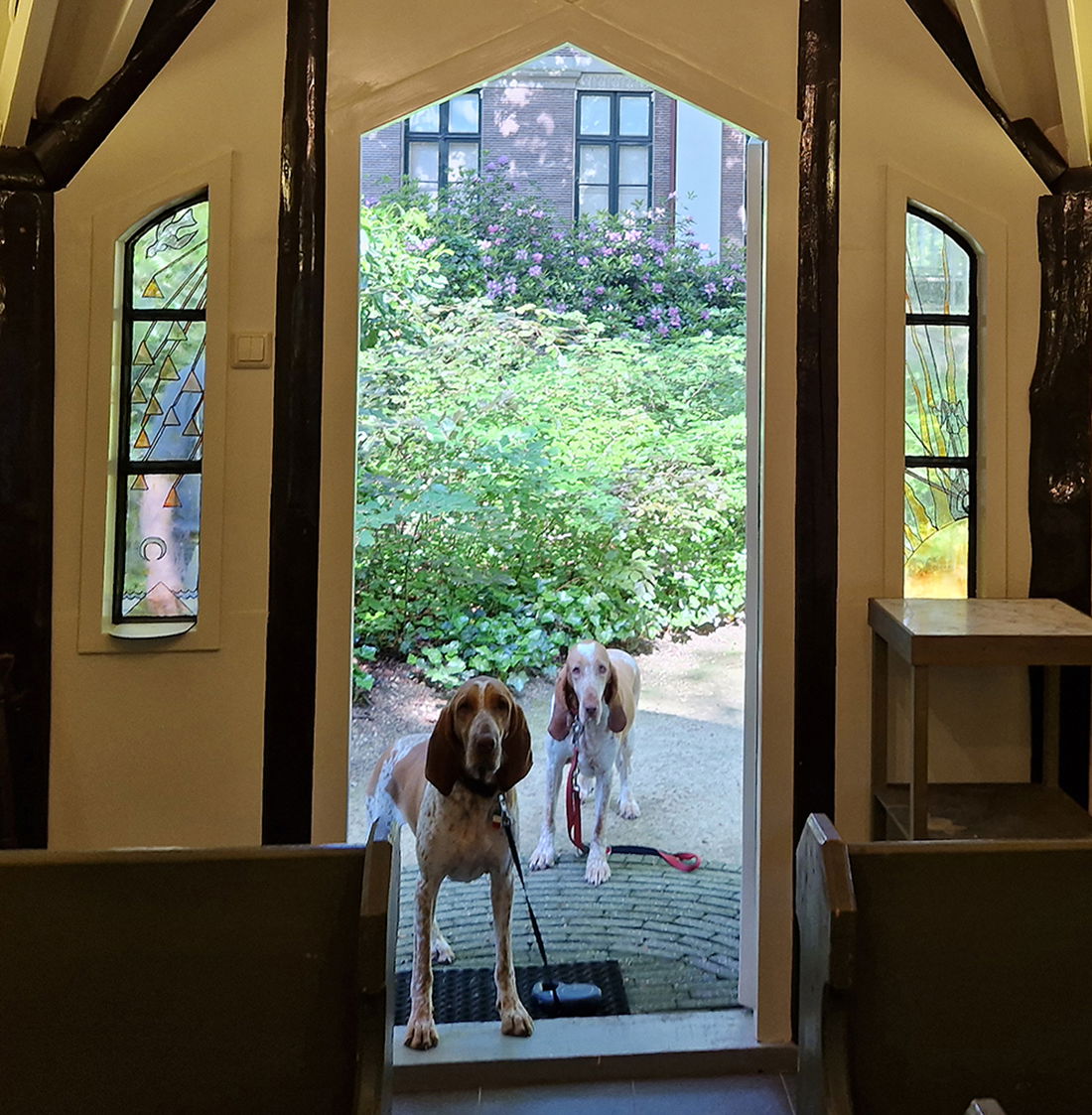
My Bracco Italiano hunting dogs from Roman Catholic Italy "Bella Siena & Bella Giulia" were of course very curious and also wanted to see the "Chapel of the Holy Guardian Angels" from the inside.
Word of thanks
My sincere thanks go to Coos van Wageningen for helping to create this document. Searching for information, answering my endless questions, helping to photograph the chapel, reviewing drafts and making family archive material available, has brought me a lot of work but has also completed this valuable document. Together we have learned a lot and I trust that Coos, your uncle and founder of the chapel “Joachim Ferdinand de Beaufort” has been pleased with this. I can see him up there smiling on his cloud looking down. Coos, many thanks again!
In the gallery of the website you can find many more beautiful photos.
Zeist is so beautiful and how lucky we are to live here.
Until the next walk on the Molenbosch country estate, Arnie Della Rosa
You can read my walking stories as well as the columns of other Zeist columnists at https://www.zeistermagazine.nl